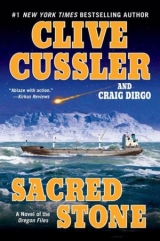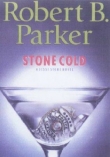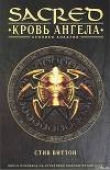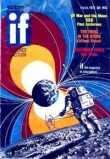
Текст книги "Sacred Stone"
Автор книги: Clive Cussler
Жанр:
Морские приключения
сообщить о нарушении
Текущая страница: 1 (всего у книги 26 страниц)
SACRED STONE
C LIVE C USSLER and CRAIG DIRGO
BERKLEY BOOKS, NEW YORK
The explosive first novel of the Oregon Files was hailed as “honestly fabulous” ( Kirkus Reviews). Now, Clive Cussler, creator of the bestselling NUMA ®and Dirk Pitt ®series, continues the adventure and intrigue with enigmatic high-seas action hero Juan Cabrillo and his high-tech spy ship, the Oregon…
In the remote wastes of Greenland, a young scientist has unearthed an artifact hidden in a cave for a millennium: a 50,000-year-old radioactive meteorite known as the Sacred Stone. But the astounding find places him in the crosshairs of two opposing groups who seek the stone for themselves.
One is a group of Muslim extremists who have stolen a nuclear device. With the power of the meteorite, they could vaporize any city in the West. The other group is led by a megalomaniacal industrialist who seeks to carry out the utter annihilation of Islam itself.
Caught between two militant factions bent on wholesale slaughter, Juan Cabrillo and his crew must fight to protect the scientist and the Sacred Stone—and prevent the outbreak of World War III…
Contents
Cast of Characters
Prologue
Part One
Chapter 1
Chapter 2
Chapter 3
Chapter 4
Chapter 5
Chapter 6
Chapter 7
Chapter 8
Chapter 9
Chapter 10
Chapter 11
Chapter 12
Chapter 13
Chapter 14
Chapter 15
Chapter 16
Chapter 17
Chapter 18
Chapter 19
Chapter 20
Chapter 21
Chapter 22
Chapter 23
Chapter 24
Chapter 25
Chapter 26
Chapter 27
Chapter 28
Chapter 29
Chapter 30
Chapter 31
Chapter 32
Chapter 33
Chapter 34
Chapter 35
Chapter 36
Chapter 37
Chapter 38
Chapter 39
Chapter 40
Chapter 41
Part Two
Chapter 42
Chapter 43
Chapter 44
Chapter 45
Chapter 46
Chapter 47
Chapter 48
Chapter 49
Chapter 50
Chapter 51
Chapter 52
Chapter 53
Epilogue
Postscript
DIRK PITT ®ADVENTURES BY CLIVE CUSSLER
Trojan Odyssey
Valhalla Rising
Atlantis Found
Flood Tide
Shock Wave
Inca Gold
Sahara
Dragon
Treasure
Cyclops
Deep Six
Pacific Vortex
Night Probe
Vixen 03
Raise the Titanic !
Iceberg
The Mediterranean Caper
DIRK PITT ®ADVENTURES BY CLIVE CUSSLER AND DIRK CUSSLER
Treasure of Khan
Black Wind
KURT AUSTIN ADVENTURES BY CLIVE CUSSLER WITH PAUL KEMPRECOS
Polar Shift
Lost City
White Death
Fire Ice
Serpent
Blue Gold
OREGONFILES ADVENTURES BY CLIVE CUSSLER WITH JACK DU BRUL AND CRAIG DIRGO
Skeleton Coast
Dark Watch
Sacred Stone
Golden Buddha
NONFICTION BY CLIVE CUSSLER AND CRAIG DIRGO
The Sea Hunters II
The Sea Hunters
Clive Cussler and Dirk Pitt Revealed
CHILDREN’S BOOKS BY CLIVE CUSSLER
The Adventures of Vin Fiz
THE BERKLEY PUBLISHING GROUP
Published by the Penguin Group
Penguin Group (USA) Inc.
375 Hudson Street, New York, New York 10014, USA
Penguin Group (Canada), 90 Eglinton Avenue East, Suite 700, Toronto, Ontario M4P 2Y3, Canada (a division of Pearson Penguin Canada Inc.)
Penguin Books Ltd., 80 Strand, London WC2R 0RL, England
Penguin Group Ireland, 25 St. Stephen’s Green, Dublin 2, Ireland (a division of Penguin Books Ltd.)
Penguin Group (Australia), 250 Camberwell Road, Camberwell, Victoria 3124, Australia (a division of Pearson Australia Group Pty. Ltd.)
Penguin Books India Pvt. Ltd., 11 Community Centre, Panchsheel Park, New Delhi—110 017, India Penguin Group (NZ), 67 Apollo Drive, Rosedale, North Shore 0632, New Zealand (a division of Pearson New Zealand Ltd.)
Penguin Books (South Africa) (Pty.) Ltd., 24 Sturdee Avenue, Rosebank, Johannesburg 2196, South Africa
Penguin Books Ltd., Registered Offices: 80 Strand, London WC2R 0RL, England
This is a work of fiction. Names, characters, places, and incidents either are the product of the author’s imagination or are used fictitiously, and any resemblance to actual persons, living or dead, business establishments, events, or locales is entirely coincidental. The publisher does not have any control over and does not assume any responsibility for author or third-party websites or their content.
SACRED STONE
A Berkley Book / published by arrangement with Sandecker, RLLLP
Copyright © 2004 by Sandecker, RLLLP.
All rights reserved.
No part of this book may be reproduced, scanned, or distributed in any printed or electronic form without permission. Please do not participate in or encourage piracy of copyrighted materials in violation of the author’s rights. Purchase only authorized editions.
For information, address: The Berkley Publishing Group, a division of Penguin Group (USA) Inc., 375 Hudson Street, New York, New York 10014.
ISBN: 1-4295-9964-2
BERKLEY ®
Berkley Books are published by The Berkley Publishing Group, a division of Penguin Group (USA) Inc.,
375 Hudson Street, New York, New York 10014.
BERKLEY ®is a registered trademark of Penguin Group (USA) Inc.
The “B” design is a trademark belonging to Penguin Group (USA) Inc.
SACRED STONE
C AST OF C HARACTERS
JUAN CABRILLO:
Chairman of the Corporation
MAX HANLEY:
President of the Corporation
RICHARD TRUITT:
Vice President of the Corporation
THE CORPORATION TEAM (OPERATIVES)(in alphabetic order)
GEORGE ADAMS:
Helicopter Pilot
RICK BARRETT:
Assistant Chef
MONICA CRABTREE:
Supply and Logistics Coordinator
CARL GANNON:
General Operations
CHUCK “TINY” GUNDERSON:
Chief Pilot Fixed-Wing
MICHAEL HALPERT:
Finance and Accounting
CLIFF HORNSBY:
General Operations
JULIA HUXLEY:
Medical Officer
PETE JONES:
General Operations
HALI KASIM:
General Operations
LARRY KING:
Sniper
FRANKLIN LINCOLN:
General Operations
BOB MEADOWS:
General Operations
JUDY MICHAELS:
Pilot
MARK MURPHY:
General Operations
KEVIN NIXON:
Magic Shop Specialist
TRACY PILSTON:
Pilot
SAM PRYOR:
Propulsion Engineer
GUNTHER REINHOLT:
Propulsion Engineer
TOM REYES:
General Operations
LINDA ROSS:
Security and Surveillance/General Operations
EDDIE SENG:
Director of Shore Operations/General Operations
ERIC STONE:
Control Room Operator/General Operations
THE OTHERS
LANGSTON OVERHOLT IV:
CIA officer who hires the Corporation
HALIFAX HICKMAN:
Billionaire industrialist
CHRIS HUNT:
U.S. Army officer killed in Afghanistan
MICHELLE HUNT:
Mother of Chris
ERIC THE RED:
Legendary explorer
THE EMIR OF QATAR:
Leader of the country of Qatar
JOHN ACKERMAN:
Archaeologist who locates the meteorite in Greenland
CLAY HUGHES:
Assassin hired to recover the Greenland meteorite
PIETER VANDERWALD:
South African death merchant
MIKE NEILSEN:
Pilot hired to fly Hughes to Mount Forel
WOODY CAMPBELL:
Drunk in Greenland who rents Cabrillo a snowcat
ALEIMEIN AL-KHALIFA:
Terrorist planning to bomb London
SCOTT THOMPSON:
Leader of the team on the
Free Enterprise
THOMAS “TD” DWYER:
CIA scientist who discovers the meteorite’s danger
MIKO “MIKE” NASUKI:
NOAA astronomer who assists Dwyer
SAUD AL-SHEIK:
Saudi procurement official for the hajj
JAMES BENNETT:
Pilot who transports the meteorite from the Faeroe Islands to England
NEBILE LABABITI:
Terrorist for London operation
MILOS COUSTAS:
Captain of the
Larissa,
the ship that delivers the bomb to England
BILLY JOE SHEA:
Owner of a 1947 MG TC Cabrillo borrows to chase the bomb
ROGER LASSITER:
Disgraced CIA agent who delivers the meteorite to Maidenhead
ELTON JOHN:
Legendary musician
AMAD:
Young Yemeni who will deliver the bomb
DEREK GOODLIN:
Whorehouse owner in London
JOHN FLEMING:
Head of MI5
DR. JACK BERG:
CIA doctor who forces Thompson to talk
WILLIAM SKUTTER:
Air Force captain who leads the team in Medina
PATRICK COLGAN:
Army warrant officer heading the team to recover prayer rugs in Riyadh
PROLOGUE
FIFTY THOUSAND YEARSago, and millions of miles from Earth, a planet was twitching convulsively to herald her destruction. The planet was ancient but her eventual demise had been cast from the start. She was an unstable orb with poles that constantly shifted polarity.
The planet consisted of rock and magma with a metal core. Over the countless eons since it had formed and cooled, an atmosphere was born. The gaseous layers were comprised of argon, helium and some hydrogen. Life was born on the surface of the planet—a low, base form of microbe.
The planet never really had a chance to develop complicated life forms. The microbes consumed oxygen molecules to multiply, keeping the surface and atmosphere barren of cells that could evolve. The planet’s surface rock turned into superheated liquid mush as each revolution around its sun drew it closer toward the fiery furnace. The planet revolved not in a spin around her axis like Earth, but rather in an ever-increasing barrel roll as the poles shifted, and the melted rock surface began to spread like lava from a volcano.
Each hour, each minute, each second brought her closer to her sun, and she gradually shed her skin as if the hand of God were scraping her surface with a wire brush.
The stellar dandruff that was cast into the atmosphere reached the edge of the gaseous envelope and was turned white-hot by the sun, bursting with the force of a thousand nuclear bombs. Sucked back to the surface by gravity, the reentering projectiles ripped more of the fragile crust away. More and more of the crust dissolved.
The doomed planet had only a short time to live.
As the protective covering was lost to space, the inner metal core temperature continued to rise and the orb inside began to spin. Large cracks in the surface spread and fractures formed, releasing larger and larger chunks of molten rock into space. And all the while the planet’s metal core grew with incredible intensity. Then, all at once, it happened. A massive slab of rock on the side closest to the sun gave way. The poles shifted one last time and the planet began spinning wildly.
Then she exploded.
Millions of metal orbs flew into space, their molecules rearranging themselves as they melted like solder under a flame. A lucky few made it past the gravitational field of the sun. Then they headed on a long journey into the deep reaches of space.
TENS OF THOUSANDS of years had passed since the unknown planet exploded, scattering its remains into the universe. From a great distance the approaching debris appeared blue. One piece became a finely detailed orb. Many fragments had been sucked toward the surfaces of other planets in space, but this one traveled farther than the rest and eventually came to rain down on a planet called Earth.
The single metal orb entered Earth’s atmosphere on a low trajectory from west to east. She split in the ionosphere and calved off a smaller spherical orb of pure metal. The mother meteor came in along thirty-five degrees latitude. At this latitude, it was dry and arid. The baby, lighter and smaller, was pulled farther northwest, heading toward the sixty-second-degree latitude, where the surface was covered with a layer of ice and snow.
Two different environments of the same planet brought two different results.
The mother and her molten metal reformed into a glowing orb after spitting out her young. She came over a coastline then streaked across a barren desert in a decaying trajectory. Blasting high above the sand, rocks, and cactus, the one-hundred-yard diameter, 63,000-ton nickel-iron projectile slammed into the earth, carving a one-mile-diameter crater in the dry soil. Clouds of dust headed skyward, then began encircling Earth. Months would pass before all the fallout filtered back to the earth.
The baby was pure and silver-gray. The action of the initial explosion and the molecular rearrangement while traveling through space had formed a perfect sphere that appeared like twin halves of geodesic domes locked together. Traversing farther along the planet, she slipped through space quietly, her smooth surface meeting little resistance from Earth’s atmosphere, with none of the anger and rage her mother had contained. She dropped lower and lower, like a golf ball with a topspin.
Soaring over the shoreline of an island capped with ice, it was as if she was being pulled to the earth by a magnet. Her diameter was but eighteen inches, her weight a hundred pounds. Drifting lower until she was only ten feet over the snow and ice, she lost her forward speed as gravity brought her down. Her heated metal surface melted a track in the snow and ice similar to a ball rolled by a child to make a snowman.
Energy expended, her heat dissipated, she came to rest at the base of an ice-covered mountain.
“WHAT HATH HELL wrought?” the man asked in Icelandic as he poked an object with a staff.
The man was short but formed of layers of muscle that signaled years of hard work and labor. The hair on his head and the thick beard that grew from his cheeks was a brilliant red like the fires of Hades. Thick white furs covered his torso, while his leggings were constructed of sealskin lined with sheep’s wool. The man was prone to fits of rage, and truth be told, he was not far removed from a barbarian. Banished from Iceland for murder in the year 982, he had led a group across the cold sea to the ice-shrouded island where they now resided. During the past eighteen years he had built a settlement on the rocky coast and his colony had survived by hunting and fishing. In time he had grown bored. The man, Eric the Red, began longing to explore, to lead, to conquer new lands.
In the year A.D. 1000 he set out to see what lay inland to the west.
Eleven men accompanied him at the start, but some five months into the expedition, with spring coming, there were but five remaining. Two had slipped into crevasses in the ice, their screams still coming to Eric as he slept. One had slipped on ice and bashed his head on a rocky outcropping. He had twitched in tormented pain for days, unable to see or speak until he blissfully died one night. One had been taken by a large white ursine when he ventured away from a campfire one evening in search of a freshwater stream he swore he’d heard nearby.
Two had been taken by disease, suffering racking coughs and fevers that convinced the remaining survivors that evil forces were lurking nearby and stalking. As the expedition party thinned, the mood greatly changed. The elation and sense of wonder that compelled the men at the start had faded, replaced with a sense of doom and fatalism.
It was as if the expedition was cursed and the men were paying.
“Hoist the ball,” Eric ordered the youngest man in the expedition, the only one to have been born on island soil.
The teenager, Olaf the Fin, son of Olaf the Fisherman, was apprehensive. The strange gray orb rested on a rocky outcropping as if placed there by the hand of God. He had no way of knowing that the object had descended from the sky some forty-eight thousand years before. Olaf approached the orb cautiously. Everyone in the party knew of Eric’s penchant for violence; in fact, everyone on the icy island knew his legend. Eric was not asking—he was demanding—so Olaf did not attempt to disagree or argue. He merely swallowed hard and bent down.
Olaf’s hands touched the object and he found the surface cold and smooth. For the briefest of instants he felt his heart miss a beat—but he continued on. He attempted to lift the orb but found it too heavy for his expedition-weary arms.
“I’ll need help,” Olaf said.
“You,” Eric said, motioning to another man with his staff.
Gro the Slayer, a taller man with light yellow hair and pale blue eyes, took three steps forward and grabbed one side of the orb. Both men used their back muscles and lifted the orb to hip level, then stared at Eric.
“Make a sling from the tusked one’s skin,” Eric pronounced. “We will take it back to the cave and build a shrine.”
Without another word, Eric set off across the snow, leaving the others to tend to the discovery. Two hours later the orb was safely inside the cave. Eric immediately began planning an elaborate enclosure for the object he now believed had come directly from the gods in the heavens above.
ERIC LEFT OLAF and Gro to guard the heavenly body while he returned to the settlement on the coast for more men and material. Once there, he learned that a son had been born to his wife in his absence. He named him Leif in honor of the spring season, then left him with his mother to raise. With eighty more men and tools to excavate the cavern where the orb was hidden, he set off north toward the distant mountain. Summer was near and the sun was visible around the clock.
GRO THE SLAYER turned on his pelt bed then spat some loose fur from his mouth.
Rubbing his hand across the bearskin, he watched in surprise as the fur balled up in his palm. Then he stared at the orb in the dancing light of a torch placed in the wall.
“Olaf,” he said to the teenager sleeping a short distance away, “it is time to rise and face the day.”
Olaf rolled over and stared toward Gro. His eyes were red and bloodshot and his skin blotchy and flaking. He coughed lightly, sat upright and stared at Gro through the dim light. Gro’s hair had been shedding and his color was all wrong.
“Gro,” Olaf said, “your nose.”
Gro raised the back of his hand to his nose and saw the red of blood. More and more often he had found himself with a bloody nose. He reached down and tugged on a painful tooth. It came out in his fingers. He tossed it aside and rose to his feet.
“I’ll cook the berries,” he said.
Stirring the fire, he added a few sticks from their dwindling supply then retrieved a sealskin bag containing the red berries they boiled to make a bitter morning drink. Walking outside the cave, he filled a dented iron pot with water from the stream of a nearby melting glacier, then stared at the marks scratched on the wall outside the cave.
Two or three more marks and Eric the Red was due to return.
By the time Gro returned inside the cave, Olaf was standing, dressed in his lightweight leather pants with his shirt laid on a rock nearby. He was scratching his back with a stick, and the skin was flickering to the ground like the first light snow of a new winter season. Once the itching had subsided he slid his leather shirt over his head.
“Something is amiss,” Olaf said. “Both of us are becoming sicker as each day passes.”
“Maybe it is the foul air inside this cave,” Gro said quietly, placing the pot on the fire.
“I think it is that,” Olaf said, pointing to the orb. “I think it is possessed.”
“We could move outside the cave,” Gro said, “and erect a tent for living.”
“Eric ordered us to stay inside the cave. I fear if he returns and finds us outside we will feel his wrath.”
“I looked at the marks,” Gro said. “He is due to return in three sleeps—no more.”
“We could take turns watching for his return,” Olaf said quietly, “then hurry back inside before he catches us.”
Gro stirred the berries in the boiling water. “Sudden death or slow sickness—I think it best we avoid what we know will happen for what might or might not.”
“A few more days,” Olaf said.
“A few more days,” Gro said as he placed an iron dipper into the pot. He filled a pair of iron bowls with the berry liquid and handed one to Olaf.
FOUR MARKS ON the entrance of the cave later, Eric the Red returned.
“You have the racking cough,” he said as soon as he saw the condition of the men. “I do not want you to infect the others. Return to the settlement but take up residence in the log house to the north.”
Olaf and Gro set off to the south the following morning—but they never reached home.
Olaf went first, his weakened heart simply giving out three days after the start of the journey. Gro didn’t fare much better, and when he could walk no more he made camp. The furry beasts came soon after. What wasn’t consumed immediately was spread about by the carnivores until it was as if Gro had never existed at all.
AFTER WATCHING HIS two men disappear into the distance, Eric gathered the miners, engineers and laborers he had brought from the settlement. He cleared a spot in the dust on the floor of the cave and began sketching his plans with a stick.
The plans were ambitious, but a gift from heaven should not be treated lightly.
That day the first parties began to map out the cave. In time it would be learned that the cave stretched nearly a mile into the mountain and the temperature increased as the cavern ran downward. A large pool with freshwater was located deep inside, with stalactites descending from the ceiling and stalagmites rising from the floor.
Groups were sent to the coast to locate long poles of driftwood to construct a series of ladders up and down the passages, while others carved steps into the rock. Intricate doors were fashioned from slabs of rock that pivoted on balanced hinges to hide the object from others who might seek her power. Runic carvings and statues were hewn from the rock, and light was reflected from the few openings where fresh air entered the cave. Eric supervised the work from the settlement on the coast. He visited the site rarely, letting the vision in his mind be his guide.
Men came, worked, became sick and died, only to be replaced by others.
By the time the cavern was finished, Eric the Red had decimated his population base and the settlement would never recover. Only once did his son, Leif, see the glorious monument.
Eric ordered the entrance sealed, and the object was left for those yet to come.








